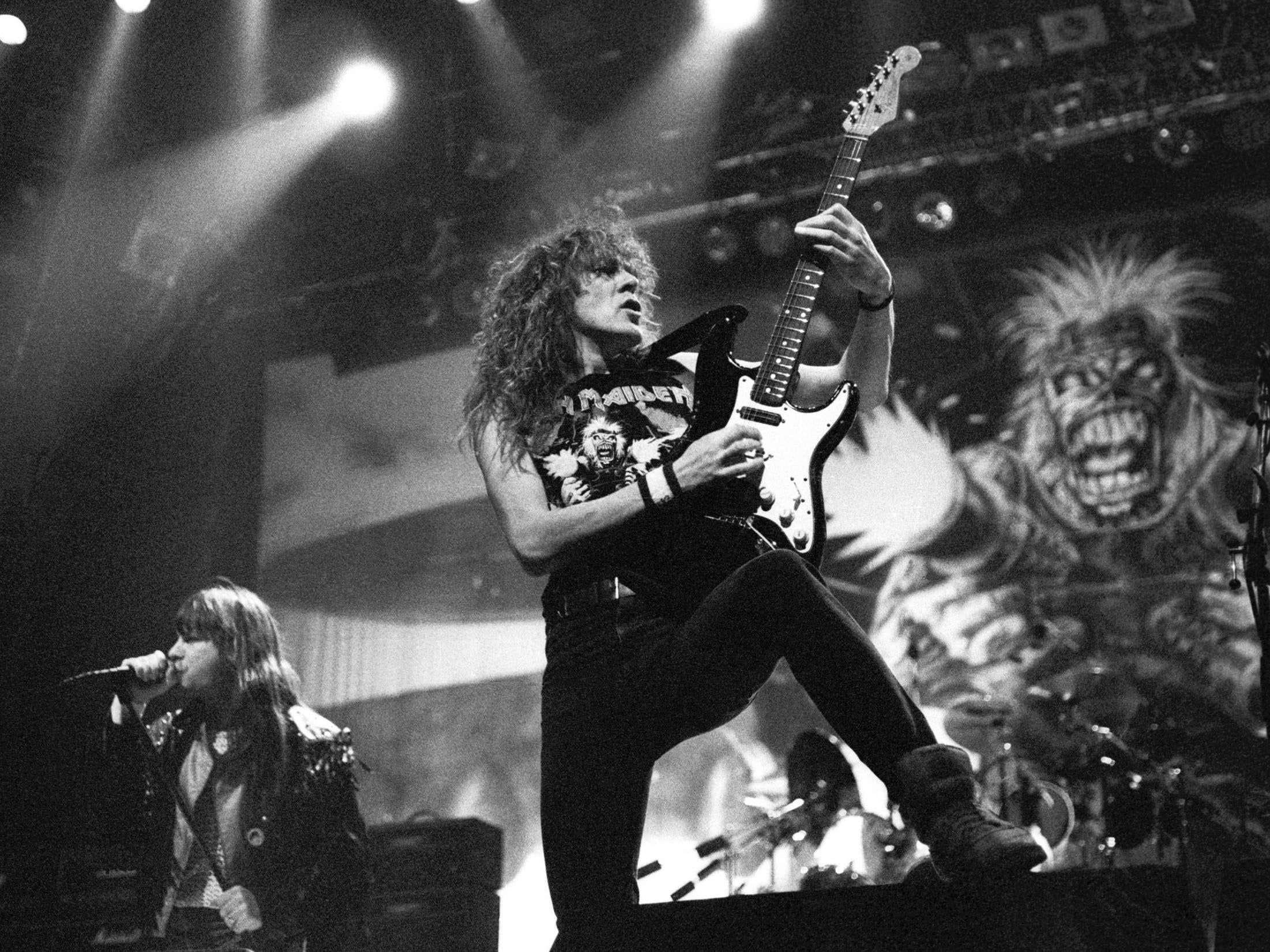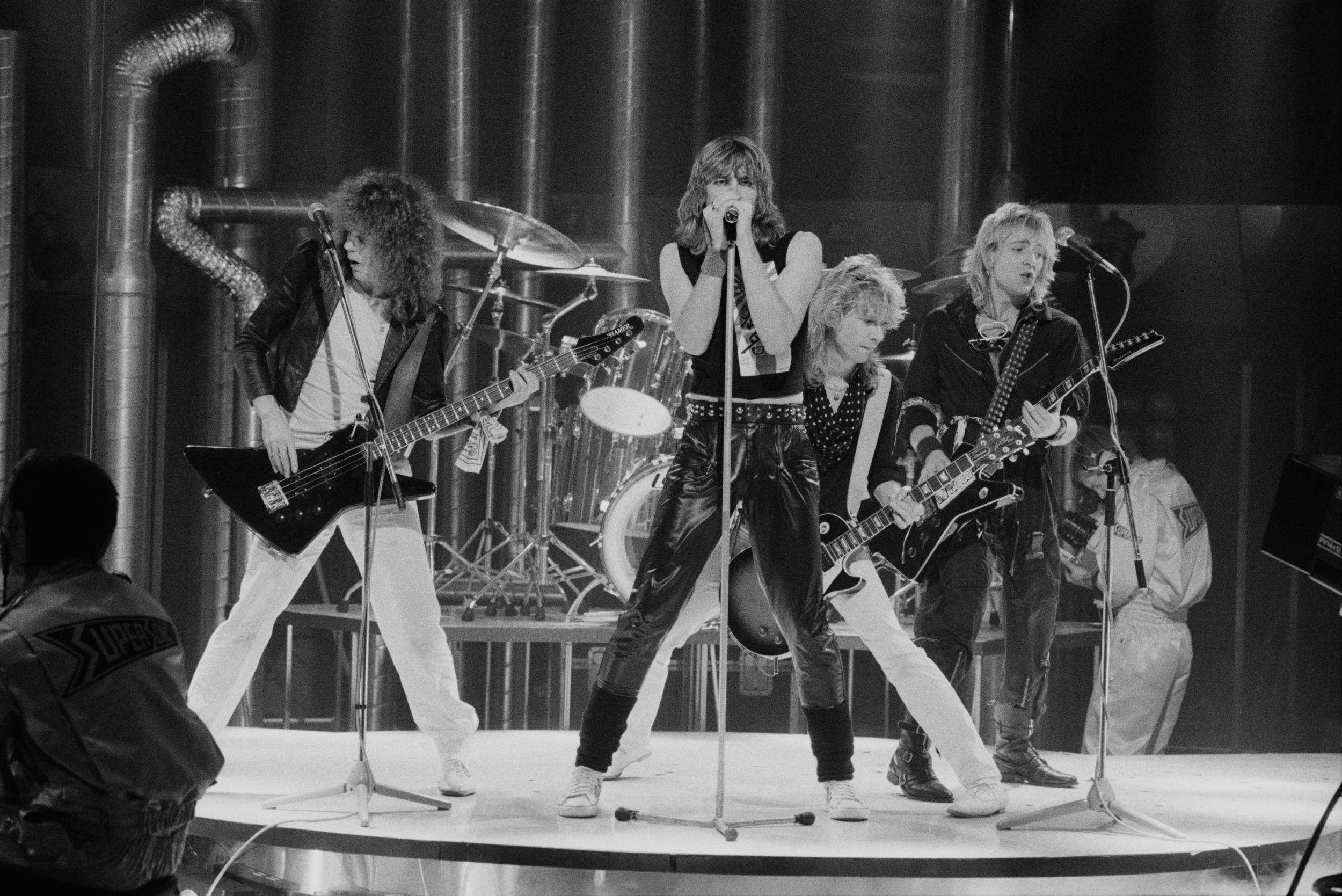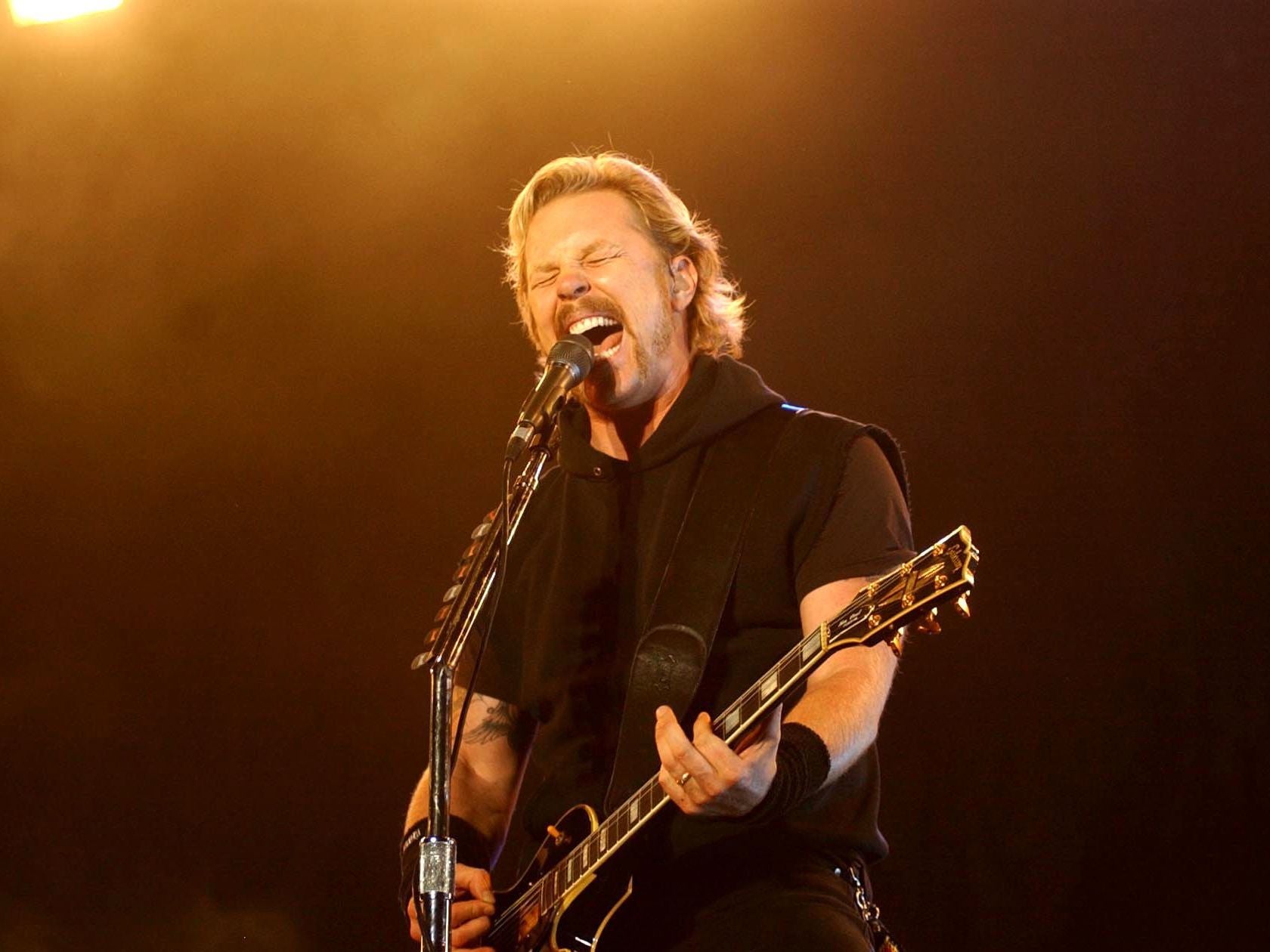‘We came out of anarchy’: How the new wave of British heavy metal changed the face of rock’n’roll
As Iron Maiden’s self-titled debut album turns 40, Ed Power looks back on the musical movement, coined ‘NWOBHM’, that had a decent crack at conquering the world

Your support helps us to tell the story
From reproductive rights to climate change to Big Tech, The Independent is on the ground when the story is developing. Whether it's investigating the financials of Elon Musk's pro-Trump PAC or producing our latest documentary, 'The A Word', which shines a light on the American women fighting for reproductive rights, we know how important it is to parse out the facts from the messaging.
At such a critical moment in US history, we need reporters on the ground. Your donation allows us to keep sending journalists to speak to both sides of the story.
The Independent is trusted by Americans across the entire political spectrum. And unlike many other quality news outlets, we choose not to lock Americans out of our reporting and analysis with paywalls. We believe quality journalism should be available to everyone, paid for by those who can afford it.
Your support makes all the difference.Britain in 1980 felt like a country hurtling towards the End of Days. Industrial strife was brewing in the factories and mining towns. The previous May, Margaret Thatcher had taken up residence in 10 Downing Street and would soon prove the most divisive prime minister of the postwar era. The Cold War cast an apocalyptic shadow. All was grim and dank. It was a world rendered in Ford Cortina-beige.
This was the backdrop against which an upstart generation of British headbangers and mane-shakers changed the face of rock’n’roll. Along the way, they had a decent crack at conquering the world. Sales of denim jackets and sew-on patches received a historical boost, too.
Unlike their punk and glam predecessors, rock’s latest saviours weren’t arty or pretentious. Anything but. It was all about escapism for Iron Maiden – who released their self-titled debut album 40 years ago on 14 April – and for peers and rivals such as Saxon, Def Leppard, Angel Witch and Diamond Head.
The music was loud and theatrical – and, listened to today, surprisingly melodic. You went to a Maiden show – at the 900-capacity Soundhouse in north London or, later, Hammersmith Odeon – and for 90 minutes, obliterated your woes in a frenzy of fist-pumping, with the bonus that you could sing along to the tunes. This was the new wave of British heavy metal (Or “NWOBHM” – pronounced “nuh-wob-um”) and for a while it seemed it might remake rock in its own image.
“England was a bit chaotic at the time,” recounts Biff Byford, a former miner from Barnsley who founded NWOBHM mainstays Saxon in 1977. “There was a mood in the country. The punk thing had run its course. We were into [the era of] early Thatcher, the miner strikes and things. There was a bit of anarchy going on. We came out of that.”
With Saxon and the even more commercially successful Iron Maiden and Def Leppard, NWOBHM put a distinctly British stamp on rock. As Byford said, punk had fizzled out. And many disenfranchised fans of the genre turned to the burgeoning metal scene instead.
“We got a lot of former punks, a few bikers, some Motörhead fans coming to our shows,” says Byford. “We connected with all those people. We had some fairly good songs, too. It wasn’t all about the fashion.”
“You can absolutely see the connections with punk in the British metal scene at that point,” says Metal Hammer editor Merlin Alderslade, “not least with Iron Maiden, whose early material and image had far more in common with punk rock than the epic, progressive metal that their music would later embrace. It’s easy to think of the NWOBHM as one unified scene of bands that all sounded the same. The reality is that it was a complex movement that took ingredients from a ton of things going on in music at the time.”
The NWOBHM has gained a semi-mythic position in rock folklore. One reason may be that many of the bands – even those regarded at the time as failing to live up to their potential – are still functioning entities to one degree or another. The Clash and the Sex Pistols live on only in legend. But – if and when normality resumes – you can still catch a show by Diamond Head or Angel Witch. Heavy metal was built to endure, where other music scenes, from punk to Britpop, were destined to flicker briefly and fade away.
Enjoy unlimited access to 100 million ad-free songs and podcasts with Amazon Music
Sign up now for a 4 month free trial (3 months for non-Prime members)
Enjoy unlimited access to 100 million ad-free songs and podcasts with Amazon Music
Sign up now for a 4 month free trial (3 months for non-Prime members)
Metal’s longevity is also helped by the fact that many of rock’s hoariest cliches have their origins in this period. It’s no coincidence that, before filming their iconic 1984 rockumentary, the comedians behind satirical band Spinal Tap went on tour with Saxon and lapped up the on-the-road antics. Leather trousers, crazed groupies, biblical bass solos, Stonehenge stage-props fashioned from painted plywood, drummers wearing headbands, drooping moustaches – all of it is baked into the DNA of the NWOBHM.
The real life Spinal Tap-isms were, if anything, even more ludicrous than what ended up in the film. Londoners Samson, for instance, counted in their ranks not only future Iron Maiden vocalist Bruce Dickinson but drummer “Thunderstick” (real name Barry Graham Purkis). His signature look featured a leather mask worn on- and off-stage and a wobbly metal cage that he performed inside. Sounds reporter Geoff Barton (who would later found Kerrang!) recalled interviewing Samson and being struck by Thunderstick spending the entire time clearing his throat. Later, he was informed that the drummer had been trying to scare him. He’d presumed the poor chap had a speech impediment.
“I had all the gear,” says Angel Witch frontman Kevin Heybourne. “Big old crucifixes, spandex leggings with thigh-length boots, these kind of floaty shirts. And we had all the extra on stage lighting and pyros to go with it. You needed all that back then, and your own PA. Even just to play in pubs, you had to bring the lot. We were not messing around.”
This new metal uprising was regarded as dangerous rather than quaint. Iron Maiden’s Eddie the Skeleton mascot and Diamond Head’s fascination with the esoteric sword and sorcery of Michael Moorcock sparked horror in the moral majority. They’d only just seen off punk, with its gobby skin-heads and safety pins through the nose. Now here came a generation of young men (with the occasional woman) who looked as if they were in league with Satan.

“Iron Maiden literally had religious groups picketing their shows,” says Metal Hammer’s Merlin Alderslade. “There was a genuine fear of those bands at the time. Metal has always been misunderstood by those outside the scene, and that movement was no different. The very idea that Maiden, for example, could be a bunch of Satanists is hilarious. But a little bit of undeserved notoriety rarely hurt a good rock’n’roll band.”
The new wave of British heavy metal didn’t drop out of the clear blue sky. Led Zeppelin were the acknowledged founding fathers of British heavy rock, with Black Sabbath, Deep Purple and Motörhead taking up the torch through the Seventies.
But Zeppelin split in 1980, by which time Sabbath had already hit the buffers, with an alcoholic Ozzy Osbourne booted out in April 1979. Saxon would give him a break by taking him on tour as their opening act in Europe, only for him to vanish after three gigs in Germany. Motörhead were indestructible by contrast – but felt they were slightly too long in the tooth by the time NWOBHM came along to benefit meaningfully from it. They were forerunners. Now the new kids were taking over.
That isn’t to say the scene was universally embraced. “There has always been an ignorance and snobbery with regards to heavy metal, and that certainly was the case in the early Eighties where anyone with hair that crept towards the earlobe was considered to be a danger or threat to society,” says Steffan Chirazi of Silver Lining Music, the record label which today works with Saxon and all-female NWOBHM outfit Girlschool. “All these really stupid cliches were so wrong. It’s funny to think that every heavy metal musician I’ve ever known has turned out to be a thoroughly decent human being.”
“The UK media hated us,” says Kevin Heybourne of Angel Witch, whose self-titled 1980 debut is considered a NWOBHM classic. It is also the record that inspired Lars Ulrich to form Metallica in late 1981. “The idea of being into Black Sabbath in 1980 just was not hip with those guys. They used to mug us off for being doom-laden and wearing bellbottoms, like we’d missed the memo or something.”

History has proven those doubters wrong. “There is a whole genre built on that now, it just seems natural,” Heybourne continues. “At the time, the constant sniping was debilitating, and it certainly didn’t help our relationship with the record label, or the relationships within the band.”
If the new wave of British heavy metal was born anywhere, it was in a function room attached to the Prince of Wales pub at Kingsbury Circle in London (don’t bother making a pilgrimage: today it’s a Tesco Express). That was where DJ Neal Kay started putting on weekly nights at his club, the Bandwagon Heavy Metal Soundhouse.
The Soundhouse quickly became an epicentre for metal, with fans packing into the 900-capacity space to hear Kay pump the latest eardrum-troubling seven-inch out of his state-of-the-art sound system. Eventually, he convinced Sounds journalist Barton to pay a visit. In a two-page spread in the music weekly in May 1979, Barton christened the scene the “new wave of British heavy metal”. It was a mouthful, but it stuck.
Kay would eventually start putting on gigs at the Soundhouse. However, the evening a former aspiring professional footballer from Leytonstone named Steve Harris approached the decks and pressed a demo tape into the DJ’s sweaty mitts, that was all in the future. Kay, already drowning in scratchy home-recordings, was not enthused.
Still, something about Harris’s resolve struck him as outside the ordinary. At home that night, he slapped on the cassette by the young man’s group, Iron Maiden, and was blown away. He sent the bassist and songwriter a note telling him that he had better be prepared to become incredibly wealthy – because his band was certain to be a success.
“Neal was pretty dedicated to it all,” recalls Angel Witch’s Heybourne. “There were a few DJs that did heavy metal nights in the pubs. Neal just seemed to have a good knack for self-promotion, which is no bad thing.”
Up in Sheffield, the young Def Leppard were just as proactive. Joe Elliot, the singer, was barely out of school. But he knew he didn’t want to spend the rest of his life working a factory job. John Peel was DJing on stage at Sheffield University when Elliot jumped up and handed him the group’s debut EP. As with Kay and Iron Maiden, Peel was impressed by the young man’s chutzpah. He played the Def Leppard EP four nights running on his Radio 1 show. He just couldn’t get over its catchiness.
“Def Leppard were probably earmarked for America from an early age,” says Saxon’s Byford. “They signed to an American agency. They got together with some fantastic people. They found a unique sound and popped it in America, whereas we popped in Europe. Same thing, really.”
Def Leppard’s US rise was overseen by manager Peter Mensch, co-founder of the powerful musical management company Q-Prime (and future husband of former Conservative MP Louise Mensch). He was also interested in Diamond Head, the West Midlands outfit tipped, at one point, to be potentially as big as Leppard or Maiden. At the time, however, Diamond Head’s affairs were being looked after by the mother of lead singer Sean Harris.

“Our label, MCA, wanted us to change management,” recalls the group’s guitarist Brian Tatler. “Because his mother was managing us, Sean was not interested in that proposal. So the record label dropped us. Sean presumed we’d just sign to another label. That didn’t happen. In hindsight, you learn that if a label drops you, there’s got to be a reason. So other labels were wary of us after that.”
There was rivalry and excess. But, often coming from working class backgrounds, NWOBHM bands were generally cautious about becoming too distracted. If their music careers imploded, often their only option was to return to the mines or the factory. This was their one shot.
Perhaps that was why drugs weren’t prevalent in the NWOBHM scene. “We weren’t really a drug-taking band,” remembers Saxon’s Byford. “We were too working class, maybe. We never got into cocaine or heroin habits. We worked too hard to use drugs.”
Saxon are still in business, as are Angel Witch, Diamond Head and Tank. Not everyone went on to achieve fame and fortune, though. Robb Weir of the Tygers of Pan Tang – another Michael Moorcock reference – would later take a job serving drinks on the London North Eastern Railway (though the band continue to play and record). But there is no doubting the true winners.
“Def Leppard’s debut album made the top 15 in the UK, while Maiden’s debuted at No 4 so it was clear very early on that those bands had hit on something special,” says Alderslade. “What’s interesting is how they took drastically different approaches to stay at the top: Def Leppard went more polished and commercial and moved away from metal, while Maiden went heavier and more progressive and have stayed at the heart of the metal scene ever since.”
Perhaps the greatest irony in the story of NWOBHM is that the group who did best out of it weren’t even British. Released the same year as Iron Maiden’s debut, Angel Witch’s self-titled first album became a cult hit around the world. Among those to lap up its mix of howling guitars and swirling melodies was a teenager in California who had turned to music after his dream of becoming a professional tennis player had failed to work out.
“Metallica’s Lars Ulrich has never been shy about professing his love for the bands of the NWOBHM era,” says Alderslade. “And what a huge influence they were for him. Metallica’s Diamond Head covers remain iconic.”
“I joined Tank in 1984 and our first tour was supporting Metallica around Europe,” says guitarist Cliff Evans. “We did the Blood and Honour album and straight after that were offered support on the Ride the Lightning tour in the winter of 1984. We weren’t too familiar with Metallica. They had just signed to Elektra and had a management deal with Q-Prime. That was the tour that broke them. They were still really young. They were messing around on skateboards. Any money they had they would spend on comics.”
Metallica’s success had a life-changing trickle-down effect on some of the musicians who inspired them. Brian Tatler, for instance, was able to buy a house from the royalties that came his way after Ulrich and the gang covered Diamond Head’s 1980 classic “Am I Evil?” as the B-side for their 1984 single “Creeping Death”.

“Metallica were only a small band at first,” says Tatler. “And so I didn’t think it was the big deal that it turned out to be. I just thought that it was Lars’s band that had done ‘Am I Evil?’ and that it was a great version. They’d gone to the trouble to work it out – the solo and everything. It was quite flattering. They were the first band to ever cover Diamond Head.
“I didn’t think it would change everything – that it would make me a fortune. In 1984, I had no idea Metallica would become the biggest metal band of all time. By 1986, they were outselling Diamond Head 10 to one. It was fascinating to see Lars and his group rise from nothing but a garage band and achieve exactly what we would have loved to achieve.”
“We were all young and trying to be the best we could be,” says Angel Witch’s Heybourne. “It was the era of virtuosity and we all wanted to excel on our instruments and blow the other bands off stage. ‘You don’t play with them, you play against them’ as the saying goes. Even if you have a beer and a laugh with them after the show.”
Four decades on, what is the legacy of the NWOBHM? “Not everyone is going to own every single Angel Witch B-side, but the impact all those bands had on heavy music was what made it the truly global, all-conquering force it remains today,” says Merlin Alderslade. “There’s a case to be made,” he concludes, “that it’s the most important movement in metal’s history.”
Join our commenting forum
Join thought-provoking conversations, follow other Independent readers and see their replies
Comments